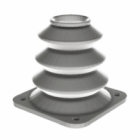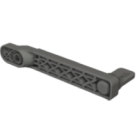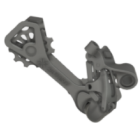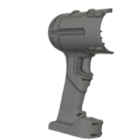Sanding 3D prints
Sanding is a crucial post-processing step in 3D printing, essential for achieving smooth, professional-quality surfaces. Whether you’re working on prototypes or end-use parts, mastering 3D printing sanding techniques can significantly enhance the final appearance and functionality of your prints.
Let’s look at how to sand 3D prints properly — and efficiently.
Understanding 3D print sanding
3D print sanding involves the gradual smoothing of printed parts to eliminate layer lines and surface imperfections. This process not only improves aesthetics but also prepares the surface for painting or coating, ensuring better adhesion and a polished finish.
When and why to sand
Sanding is commonly used on parts made from PLA, PETG, ABS, or resin prints with thicker support structures. It’s especially essential when:
- layer lines are clearly visible and need to be removed,
- you plan to coat oraz paint your 3D prints,
- support contact points leave marks,
- you want a smooth, tactile surface in functional components.
Not all prints require sanding — but if the final look or fit matters, it’s usually worth the effort.
Step-by-step guide to 3D printing sanding
Begin with coarse sandpaper (around 100–150 grit) to remove prominent layer lines. Progressively move to finer grits (220, 400, 600, and up to 1000+) for a smooth finish. For best results, especially with materials like ABS or PETG, consider wet sanding to reduce heat buildup and achieve a polished surface.
For best results:
- Use a sanding block or foam pad for flat surfaces.
- For curved or detailed parts, use flexible sandpaper or sanding sponges.
- Rinse between grits to remove plastic dust.
- Finish with very fine grit if painting or polishing is planned.
This progressive technique is key to sanding 3D prints smoothly, especially on PLA, which tends to scratch easily.
| Material | Initial grit (rough shaping) | Medium grit (layer removal) | Fine grit (smoothing / pre-paint) | Ultra-fine grit (polishing) |
|---|---|---|---|---|
| PLA | 120–150 | 220–320 | 400–600 | 800–1000+ |
| PETG | 100–150 | 220–320 | 400–600 | 800–1000 |
| ABS | 100–150 | 220–400 | 600–800 | 1000+ |
| Resin (SLA) | 220 | 320–400 | 600–800 | 1000–2000 |
| Nylon / PA | 120 | 220–320 | 400–600 | Optional (material stays matte) |
Common mistakes in 3D print sanding
Even with the right tools and intentions, it’s easy to make mistakes during the 3D print sanding process — especially if you’re working with detailed models or unfamiliar materials. Avoiding these common errors will help you achieve a smoother, cleaner, and more professional-looking finish:
Skipping grit levels is one of the most frequent issues. Moving straight from coarse to fine sandpaper can leave behind deep scratches that become even more noticeable after painting or polishing. Instead, gradually work through intermediate grits (e.g., 150 → 220 → 400 → 600+) to maintain consistency in the surface texture.
Applying too much pressure can deform delicate or thin-walled prints, especially when working with materials like PLA or PETG. Excessive force not only risks warping your part but can also generate heat, which causes plastic to smear instead of smooth. Always let the abrasive do the work, using light, controlled strokes.
Not cleaning between sanding stages often leads to cross-contamination. Leftover dust or grit from a coarser paper can scratch the surface during finer sanding, undoing your progress. Use compressed air or a clean microfiber cloth to wipe down the part before switching grits, particularly when aiming for a flawless finish on visible or functional surfaces.
Wet sanding 3D prints
Wet sanding 3D prints involves dipping the sandpaper in water to reduce friction, minimize heat, and trap dust. It’s especially useful with fine grits (400 and above) when you want a polished finish. Water acts as a lubricant, helping the paper glide and reducing the risk of melting the plastic from heat buildup — particularly important when working with ABS or PETG.
Just make sure your part is waterproof or sealed, and always dry it thoroughly between grit changes.
Using a Dremel for sanding 3D prints
For speed or detailed areas, sanding 3D prints with a Dremel can save time — but it requires precision. Use low speeds and soft attachments like sanding drums or polishing wheels. A Dremel for sanding 3D prints is best suited for rough trimming, inner corners, or quick surface prep on durable materials like ABS or PETG.
Avoid high speeds or excess pressure — it can gouge or melt the plastic.
Final notes on technique
Mastering 3D printing sanding techniques is about patience and precision. Take your time, follow the correct sanding sequence, and your results will reflect the effort — whether you’re working on prototypes, cosplay parts, or high-performance components.
Done well, sanding transforms a rough prototype into a display-worthy part, ready for priming, painting, or use.
Explore also
- Removing supports from 3D prints
- Polish 3D printed
- Sandblasting 3D prints
- How to fill gaps in 3D prints
- Priming 3D prints
- How to paint 3D print
- How to foiling 3D prints
- How to metal plating 3D print
Related categories













